Lycoperdon excipuliforme (Scop.) Pers. - Pestle Puffball
Phylum: Basidiomycota - Class: Agaricomycetes - Order: Agaricales - Family: Agaricaceae
Distribution - Taxonomic History - Etymology - Identification - Culinary Notes - Reference Sources
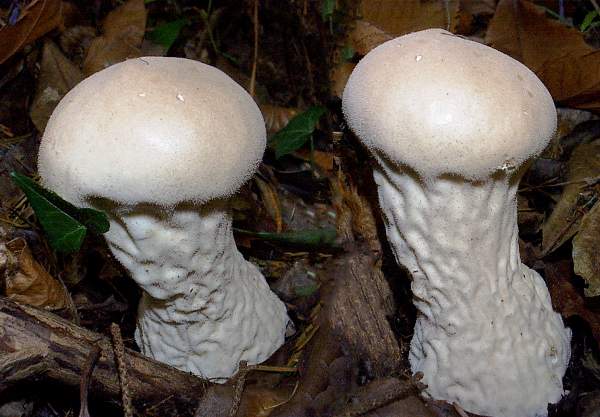
An imposing woodland fungus that is difficult to overlook, Lycoperdon excipuliforme is commonly referred to as the Pestle Puffball. It is edible only when young and white throughout.
Very much in evidence all through the year, the dead stems of the previous season’s fruitbodies persist well on into the following summer. These tall puffballs are found in all kinds of open woodland - most particularly on woodland edges and clearings - and sometimes under hedgerows.
Distribution
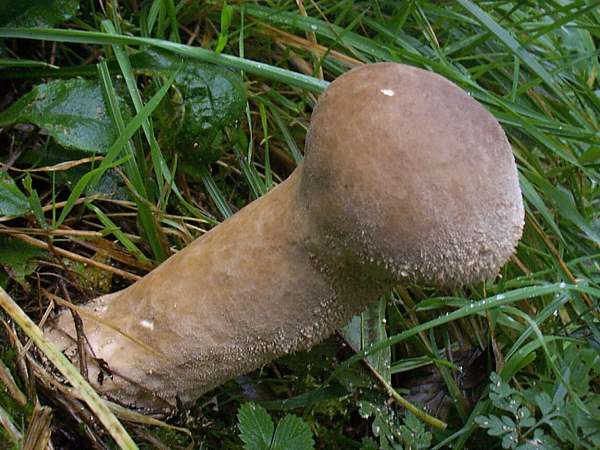
A widespread and fairly common find in Britain and Ireland, the Pestle Puffball fruits most often singly or in very small groups in woodland habitats. Lycoperdon excipuliforme is found throughout mainland Europe, and its wider distribution includes parts of North America.
Taxonomic history
When in 1772 Italian naturalist Giovanni Antonio Scopoli described this puffball he gave it the binomial scientific name Lycoperdon polymorphum var. excipuliforme. The curent name Lycoperdon excipuliforme, established by Christiaan Hendrik Persoon in 1801, retains Scopoli's basionym.
This species has many synonyms including Lycoperdon polymorphum var. excipuliforme Scop., Lycoperdon saccatum Vahl, Lycoperdon elatum Massee, Calvatia saccata (Vahl) Morgan, Calvatia excipuliformis (Scop.) Perdeck, and Handkea excipuliformis (Scop.) Kreisel.
Etymology
The specific epithet excipuliforme, comes from the Latin words excipulum, which means a vessel (a chalice, for example), and forma, which means 'in the shape of'. So we might infer that Antonio Scopoli thought the Pestle Puffball looked like some kind of (drinking) vessel. A chalice for teetotalers, perhaps?
The genus name Lycoperdon literally means 'wolf's flatulence' and begs the question who got close enough to a wolf to become an expert on the matter. For most of us, surely such an odour cannot be considered a particularly helpful diagnostic feature for identifying the Common Puffball, Lycoperdon perlatum.
Identification guide
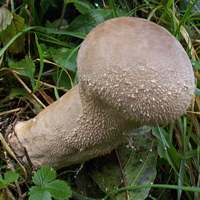 |
DescriptionThis fungus comprises two parts. The upper, globe-like section, which is white at first and turns ochre as it ages, is initially covered in soft, pointed warts; these fall off to leave a smooth, matt surface. Inside this rounded head the spores develop. The lower stem-like section comprises sterile material and soon develops a wrinkled skin. Growing to a height of 10 to 20cm; head diameter 4 to 10cm; stipe diameter usually about half the head diameter; |
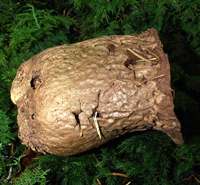 |
StemParallel or slightly tapering in at the base; spongy; surface soon becoming wrinkled; initially white with pointed warts, but later turning ochre and becoming smooth and leathery. The stems of these large puffballs expand once the head has ruptured and released the spores, and then they remain intact throughout the winter and into the following summer. An example of an over-wintered stem is shown on the left. |
SporesMore or less spherical, warted, 3.5 - 5.5µm in diameter. Spore massInitially the spore mass (gleba) is white, becoming olive and then purple-brown at maturity. |
|
Odour/taste |
Not distinctive. Edible only when young and white throughout. |
Habitat & Ecological role |
Found in broadleaf and coniferous woodland and occasionally in grassland. |
Season |
August to November in Britain and Ireland. |
Similar species |
Lycoperdon perlatum is much smaller, has a shorter stipe, and retains a mesh-like pattern when the warts are rubbed off the cap. |
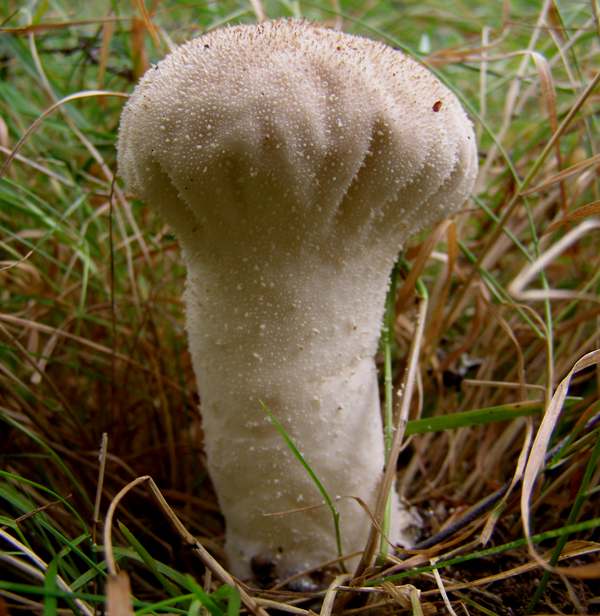
Culinary notes
Lycoperdon excipuliforme is not one of the 'Magnificent Seven' edible fungi featured in chapter 10 of Fascinated by Fungi, but nevertheless this is an edible fungus and can make a good meal if prepared and cooked properly. Here are a couple of tips. The first important step is to remove the tough outer skin - a job perhaps best done with a sharp knife. The second point is all to do with quality: use only fresh young fruitbodies which, when cut in half along the vertical axis, are white all through. Discard any that have begun turning yellow, olive or brown, as this indicates that the spores are maturing and the flavour will be seriously marred if you include them in your dish. Probably the simplest meal that you can make with puffballs is a mushroom omelet; they can also be fried or used to make soups.
There are also some poisonous gilled mushrooms which, when young, could be mistaken for Lycoperdon excipuliforme, the Pestle Puffball. The infamous Deathcap, Amanita phalloides, starts off as a rounded button mushroom, sometimes pure white or with just the faintest hint of olive.
I mention this simply to emphasise how important it is not merely to learn how to identify a range of the finest edible mushrooms but, equally importantly, to become familiar with the identifying characteristics of the poisonous fungi with which they could be confused. For more help with this important safety matter see Fascinated by Fungi; however, some introductory information on edible fungi with toxic imposters online here...
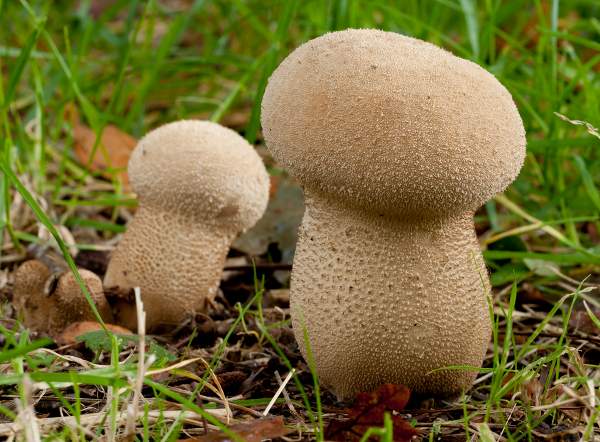
For a very easy to recognise edible puffball that cannot be mistaken for any other mushroom, see Calvatia gigantea, the Giant Puffball. Unfortunately it's not every day that you stumble across Giant Puffballs, as they are not only uncommon but also very localised in their distribution. If you find a good spot for these mighty meaty meal sources, make a note of it because Giant Puffballs, like Common Puffballs, usually reappear in the same places for many years.
Reference Sources
Fascinated by Fungi, 2nd Edition, Pat O'Reilly 2016, reprinted by Coch-y-bonddu Books in 2022.
Pegler, D.N., Laessoe, T. & Spooner, B.M (1995). British Puffballs, Earthstars and Stinkhorns. Royal Botanic Gardens, Kew.
British Mycological Society. English Names for Fungi
Dictionary of the Fungi; Paul M. Kirk, Paul F. Cannon, David W. Minter and J. A. Stalpers; CABI, 2008
Taxonomic history and synonym information on these pages is drawn from many sources but in particular from the British Mycological Society's GB Checklist of Fungi.
Acknowledgements
This page includes pictures kindly contributed by David Kelly.
Fascinated by Fungi. Back by popular demand, Pat O'Reilly's best-selling 450-page hardback book is available now. The latest second edition was republished with a sparkling new cover design in September 2022 by Coch-y-Bonddu Books. Full details and copies are available from the publisher's online bookshop...

